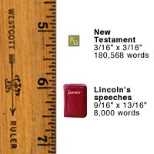While taking a nap during a particularly dry session at a scientific conference, Pawan Sinha, assistant professor of brain and cognitive sciences, dreamt that he was writing the entire Bhagavad Gita on a grain of rice.
When he awoke, he did a back-of-the-envelope calculation of the surface area of a grain of rice and the smallest typeface in microphotolithography one might use for 100 pages of Sanskrit. It seemed to him that it might actually work.
It's not the Gita and it's not on rice, but Sinha is recognized in the 2003 Guinness Book of World Records for creating the smallest printed book reproduction. He and two others (Pamela R. Lipson, a fellow Ph.D. graduate from the MIT Artificial Intelligence Laboratory; and Keith R. Kluender of the University of Wisconsin at Madison) are credited with setting the world record in 2001 with their tiny complete text of the New Testament from the King James Bible.
The book is actually a tablet that's five millimeters (0.196 inches) square. It is pictured in the Guinness record book perched on a pencil eraser. Each letter in the text is the size of a red blood cell or a small bacterium. "One can get an appreciation of the size of the text from the fact that 10 lines can comfortably fit within the thickness of a single strand of human hair," Sinha said.
With a 40X magnifier, you can barely see the overall layout of the text. The words are so small that they have to be enlarged 600 times before they can be read with the naked eye. In contrast, the smallest books in MIT's Archives and Special Collections, part of a series in presidential miniatures published in 1929 and 1930, are 13/16ths of an inch high by 9/16ths of an inch wide. One of these books contains four speeches by Abraham Lincoln in 160 pages of two-point type, around 8,000 words. The New Testament contains 180,568 words.
Superimposed in larger type on Sinha's tablet are the first and last letters of the Greek alphabet--alpha and omega--signifying that the tablet contains everything from beginning to end. They also derive from the passage in the Book of Revelations (22:13) where Christ says, "I am the Alpha and Omega, the beginning and the end, the first and the last."
Sinha studies face recognition and the brain, but a few years ago he started thinking about ways of densely storing textual and graphical information that would stand up to heat, humidity, physical trauma and strong electromagnetic radiation.
Taking advantage of the VLSI (very large scale integration) technology used for manufacturing computer microchips, Sinha worked out the software needed to print the miniscule letters in 24-karat gold on a crystalline silicon tablet.
Sinha's dream may have led to more than an exercise in tininess. Printing metal words on silicon creates an almost indestructible document, much more permanent than paper or electronic files. Sinha, Lipson and Kluender are exploring the use of this technology for robust high-density archiving and physical authentication tags.
"It could be useful for very sensitive information you want to preserve," Sinha said. "It's safe from radiation and heat, and even if part of it is broken off, the rest would be intact. Also, because it's difficult to create but easy to verify, it can serve as an effective anti-counterfeiting device."
A version of this article appeared in MIT Tech Talk on May 14, 2003.







